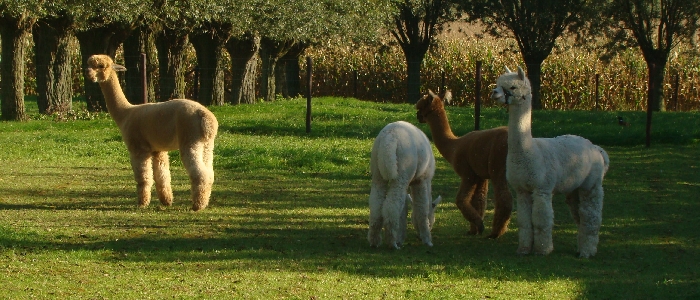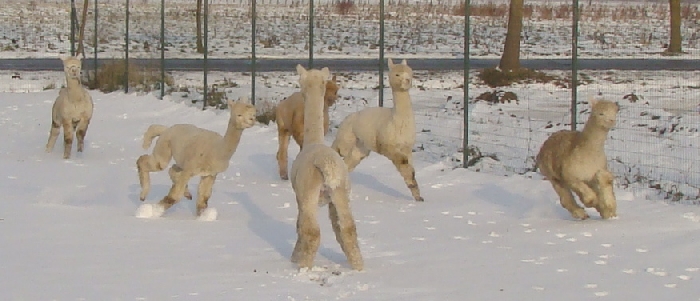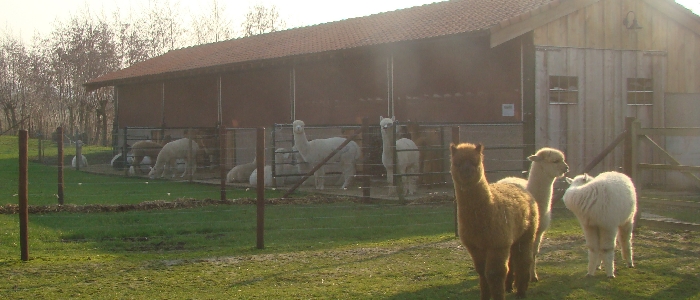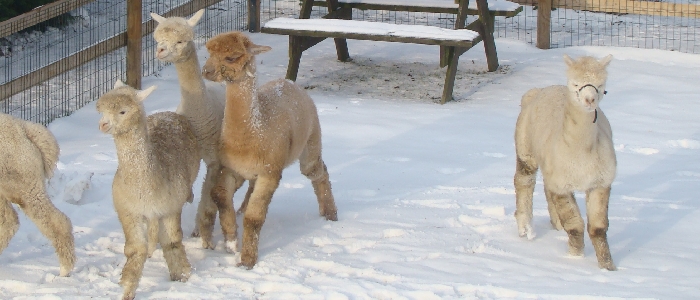Vitamine D
VITAMIN D
By Nic Cooper, Southern Alpacas Stud
In the early days of alpacas in New Zealand, the industry saw many cases of carpal valgus (bent or bowed front legs) in alpacas. These ranged from minor to the extreme. The higher concentration appeared to be amongst the darker coloured animals, and it appeared in youngsters, particularly when autumn born, during winter. At Southern Alpacas Stud one of your first cria born, in 1990, developed extreme rickets.
The effect was quickly traced, by researchers, to a vitamin D or phosphorous deficiency, and led to a lot of breeders sprinkling di-calcium phosphate on nuts, and adding other such supplements to nut mixes.
Research in the mid 1990’s (ex USA) then indicated that treatment with vitamin D alone would alleviate the clinical signs, and (ex Australia) that di-calcium phosphate was actually bad for your alpacas. But read on for 2005 information ......
Vitamin D (particularly vitamin D3 - chalecalciferol) is necessary to the alpaca to allow it to absorb calcium and phosphorous from the intestinal tract.
Calcium is the most abundant mineral in the body, phosphorous is the second most abundant. These minerals are required for proper bone development. Many enzymes and B vitamins are activated only in the presence of Phosphorous.
Phosphate is the naturally occurring form of the element phosphorus. Phosphate deficiency is what is measured in the bloods, and we treat with a phosphorus compound.
The natural Calcium/Phosphorous ratio in bones and teeth in 2:1, (although 1.5:1 in alpaca is closer to the ideal), and vitamin D is essential for maintaining this balance correctly.
Adequate vitamin D levels also minimise the loss of these two minerals through the kidneys (in excreta).
Vitamin D3 is produced through synthesis in the alpacas skin, from the action of ultraviolet light (sunlight) on cholesterol derivatives. In New Zealand the lower latitudes, and lower altitudes reduce this production, especially in winter, especially in darker pigmented animals, and especially in animals with denser fleeces.
Vitamin D also comes from consumption of sun cured dried foods, such as hay (which has vitamin D2). A lush grass diet in NZ also therefore limits the production of vitamin D in the alpaca.
In addition, on lush pastures, high concentrations of carotenes can tie up vitamin D making less available to the body.
So there are many reasons why in NZ conditions, the alpaca does not get enough vitamin D, especially in winter. Many of them are attached to sunlight and diet.
Studies in the USA (Smith, Van Saun - 1996 AAA conference proceedings) followed up work by Fowler and showed that winter vitamin D levels approximated 50% of summer levels in adult camelids, 30% of summer levels in teenagers, and close to only 10% of summer levels in juveniles (under 12 months).
Vitamin D graph
Note: graph shows northern hemisphere months! The . line shows adult levels over the year, the triangle shows teenagers and the open square line shows juveniles.
Similar work was done in Australia with similar results as part of a RIRDC project on alpacas in South Australia and Victoria in 1999 (RIRDC research project "productivity and marketing improvement of the alpaca fibre industry in Australia").
SmokeyThe classic signs are the onset of rickets, normally seen by abnormally crooked front legs in young alpacas. And this will be supported by x-rays showing abnormal growth plates, or angular limb deformities.
But there are other forms:Smokey’s legs
* A humped back posture
* A stiff gait
* Long periods lying down
* shifting lameness (from leg to leg)
* Digestive problems
* still births
* In the extreme form - quite sudden death
And in the mildest form, simply the quiet cria - the one at the back of the herd, just not as active as the others in the group.
This is particularly noticeable in the younger animal (3 to 6 months old) as this is a time of high bone mineralisation.
Blood testing for vitamin D or P levels will confirm a diagnosis.
Prevention is clearly better than cure.
Basically we are looking at a nutrition problem here, exacerbated by NZ natural feeds, and climate/latitude. One of the more traditional treatments for rickets was dosing with cod liver oil. This is logical, as fish oils are very high in vitamin D3. In fact tuna liver oil is far better, as its D3 concentration is many times that of cod liver oil.
Other more available feeds containing some (but lower) levels of Vitamin D are red clover, and lucerne hay, which may be a natural feed prevention during winter. But beware of some of the other possible side effects of red clover and lucerne hay in the reproductive, weight, and fibre quality aspects of the alpaca.
At Southern Alpacas Stud we take a more hands on approach to prevention, and inoculate all cria, regardless of colour or date of birth, with ADE or Vitamin D3 in late April and again in late June. Research has shown that such injections carry a useful life of about 2 months in a cria. We may well repeat in August, depending on the weather.
We similarly treat any cria we are suspect to be "quiet" or off colour with additional doses.
Research is showing that alpacas are very resistant to high levels of vitamin D supplementation, and there is no harm in supplementing a cria with no clinical signs.
We will also keep an eye on teenagers (12 to 24 months), and dose if we deem appropriate - better safe than sorry.
We prefer injectable vitamin D. It is more precise than oral administration, and it is 2 monthly, instead of 2 weekly for oral dosing. For injectable vitamin D, follow the body weight driven instructions on the bottle.
And if you notice a bad case of shifting lameness by all means call the vet - but be sure to get vitamin D into the animal at the first opportunity. You will see improvement almost immediately (days), although complete treatment may take weeks.
Alpacas appear resistant to high levels of vitamin D, but unfortunately the signs of too much vitamin D (hypervitaminosis), are very similar to those of too little vitamin D, with the exception of the development of calcification in soft tissues (liver etc).
Suffice it to say we have never seen a case of hypervitaminosis, and would suggest, particularly in NZ conditions, the signs you see will be through deficiency.
It has become apparent in NZ, Australia and USA in 2005 that there are alpacas now presenting with clear signs of Vit D deficiency - but that Vit D injections do not have a noticeable effect on the alpaca. Several of these this last winter have gone on to die.
The question was - "why?"
It appears that the earlier view that Vit D is enough is not correct. Despite Vit D injections these alpacas were found to have dangerously low phosphate levels in the blood.
This is fixed by injection of a phosphorus/B12 mix - we use trade name "Coforta". It has provided some quite miraculous pick-ups in a matter of a few days.
It is also suggested that DCP (di-calcium phosphate) may indeed be an appropriate non-injected form of supplement, sprinkled over food, particularly as a preventative for alpacas being placed under stress.
Research is being done by Liz Paul in Australia (in conjunction with the AAA) as to why this situation is occurring. Some interesting preliminary findings are coming out.
1) That all these effected alpacas appear to have been under some stress. Import herds that pass through quarantine are particularly affected. Weaning can affect young cria. Show teams display this effect at times. Late pregnancy and early gestation can cause this effect in the dam.
2) It is a hypothesis that stress causes a reaction in the thyroid which triggers a "dump" of phosphorous from the system. The onset of problems occurs quite quickly and to a great degree.
3) Empirically alpacas diagnosed with fatty liver disease (high AST in the bloods) are also showing very low phosphate levels in the bloods too. Is there a cause/effect reaction? This needs further research.
Over the past 12 months Southern Alpacas have noticed (or had brought to our attention by worried owners) an increasing number of cases of vitamin D and phosphate deficiencies, from very young cria, through to teenagers. All stressed alpacas in one way or another. In extreme cases this has caused quite sudden death.
Many of these have been presented to us (over the phone) with lots of other symptoms, but it is the (shifting) lameness, inability to stand in the back legs, excessive sitting, and not keeping up with the herd that triggers our diagnostic.
So be aware, be alert, and remember prevention is far better than cure.
[2009-02-23 door Nic Cooper]







